我经常使用的 3 种有用的设计模式
 英文 | https://medium.com/frontend-canteen/useful-design-patterns-48ac739882a4
英文 | https://medium.com/frontend-canteen/useful-design-patterns-48ac739882a4function getPrice(originalPrice, status){// ...return price}
其实,面对这样的问题,如果不考虑任何设计模式,最直观的写法可能就是使用if-else通过多个判断语句来计算价格。
有三种状态,所以我们可以快速编写如下代码:
function getPrice(originalPrice, status) {if (status === 'pre-sale') {return originalPrice * 0.8}if (status === 'promotion') {if (origialPrice <= 100) {return origialPrice * 0.9} else {return originalPrice - 20}}if (status === 'default') {return originalPrice}}
有三个条件;然后,我们写三个 if 语句,这是非常直观的代码。
但是这段代码并不友好。
首先,它违反了单一职责原则。主函数 getPrice 做了太多的事情。这个函数不易阅读,也容易出现bug。如果一个条件有bug,整个函数就会崩溃。同时,这样的代码也不容易调试。
然后,这段代码很难应对变化。正如我在文章开头所说的那样,设计模式往往会在业务逻辑发生变化时表现出它的魅力。
假设我们的业务扩大了,现在还有另一个折扣促销:黑色星期五,折扣规则如下:
价格低于或等于 100 美元的产品以 20% 的折扣出售。
价格高于 100 美元但低于 200 美元的产品将减少 20 美元。
价格高于或等于 200 美元的产品将减少 20 美元。
这时候怎么扩展getPrice函数呢?
看起来我们必须在 getPrice 函数中添加一个条件。
function getPrice(originalPrice, status) {if (status === 'pre-sale') {return originalPrice * 0.8}if (status === 'promotion') {if (origialPrice <= 100) {return origialPrice * 0.9} else {return originalPrice - 20}}if (status === 'black-friday') {if (origialPrice >= 100 && originalPrice < 200) {return origialPrice - 20} else if (originalPrice >= 200) {return originalPrice - 50} else {return originalPrice * 0.8}}if(status === 'default'){return originalPrice}}
每当我们增加或减少折扣时,我们都需要更改函数。这种做法违反了开闭原则。修改已有函数很容易出现新的错误,也会让getPrice越来越臃肿。
那么我们如何优化这段代码呢?
首先,我们可以拆分这个函数以使 getPrice 不那么臃肿。
function preSalePrice(origialPrice) {return originalPrice * 0.8}function promotionPrice(origialPrice) {if (origialPrice <= 100) {return origialPrice * 0.9} else {return originalPrice - 20}}function blackFridayPrice(origialPrice) {if (origialPrice >= 100 && originalPrice < 200) {return origialPrice - 20} else if (originalPrice >= 200) {return originalPrice - 50} else {return originalPrice * 0.8}}function defaultPrice(origialPrice) {return origialPrice}function getPrice(originalPrice, status) {if (status === 'pre-sale') {return preSalePrice(originalPrice)}if (status === 'promotion') {return promotionPrice(originalPrice)}if (status === 'black-friday') {return blackFridayPrice(originalPrice)}if(status === 'default'){return defaultPrice(originalPrice)}}
经过这次修改,虽然代码行数增加了,但是可读性有了明显的提升。我们的main函数显然没有那么臃肿,写单元测试也比较方便。
但是上面的改动并没有解决根本的问题:我们的代码还是充满了if-else,当我们增加或减少折扣规则的时候,我们仍然需要修改getPrice。
想一想,我们之前用了这么多if-else,目的是什么?
实际上,使用这些 if-else 的目的是为了对应状态和折扣策略。

我们可以发现,这个逻辑本质上是一种映射关系:产品状态与折扣策略的映射关系。
我们可以使用映射而不是冗长的 if-else 来存储映射。比如这样:
let priceStrategies = {'pre-sale': preSalePrice,'promotion': promotionPrice,'black-friday': blackFridayPrice,'default': defaultPrice}
我们将状态与折扣策略结合起来。那么计算价格会很简单:
function getPrice(originalPrice, status) {return priceStrategies[status](originalPrice)}
这时候如果需要增减折扣策略,不需要修改getPrice函数,我们只需在priceStrategies对象中增减一个映射关系即可。
之前的代码逻辑如下:
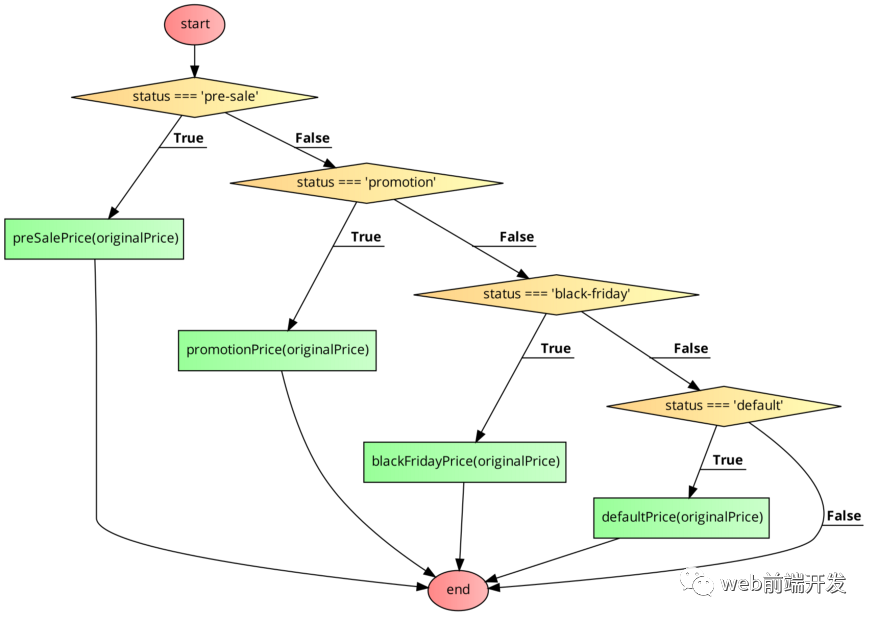
现在代码逻辑:
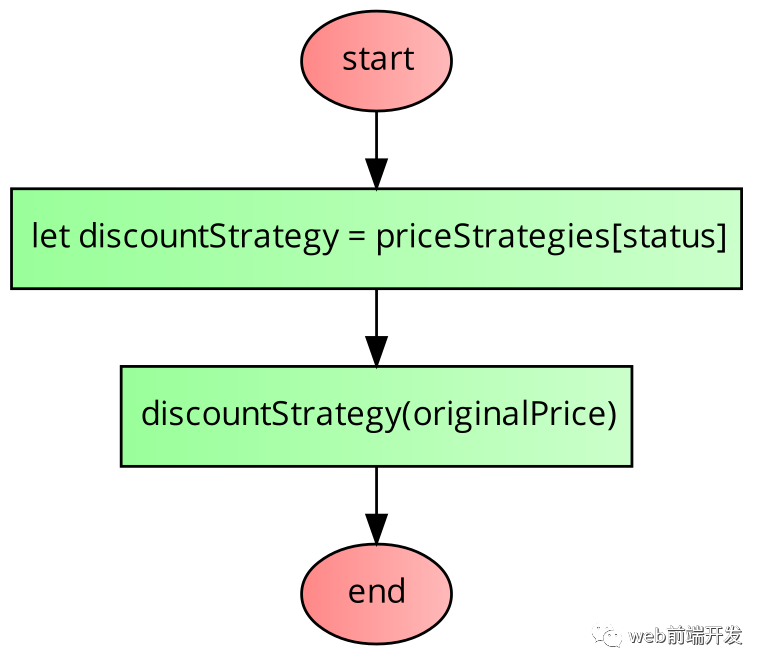
这样是不是更简洁吗?
其实这招就是策略模式,是不是很实用?我不会在这里谈论策略模式的无聊定义。如果你想知道策略模式的官方定义,你可以自己谷歌一下。
如果您的函数具有以下特征:
判断条件很多。
各个判断条件下的代码相互独立
然后,你可以将每个判断条件下的代码封装成一个独立的函数,接着,建立判断条件和具体策略的映射关系,使用策略模式重构你的代码。
02、发布-订阅模式
这是我们在项目中经常使用的一种设计模式,也经常出现在面试中。
现在,我们有一个天气预报系统:当极端天气发生时,气象站会发布天气警报。建筑工地、船舶和游客将根据天气数据调整他们的日程安排。
一旦气象站发出天气警报,他们会做以下事情:
建筑工地:停工
船舶:停泊靠岸
游客:取消行程
如果,我们被要求编写可用于通知天气警告的代码,你会想怎么做?
编写天气警告函数的常用方法可能是这样的:
function weatherWarning(){buildingsite.stopwork()ships.mooring()tourists.canceltrip()}
这是一种非常直观的写法,但是这种写法有很多不好的地方:
耦合度太高。建筑工地、船舶和游客本来应该是分开的,但现在它们被置于相同的功能中。其中一个对象中的错误可能会导致其他对象无法工作。显然,这是不合理的。
违反开闭原则。如果有新的订阅者加入,那么我们只能修改weatherWarning函数。
造成这种现象的原因是气象站承担了主动告知各单位的责任。这就要求气象站必须了解每个需要了解天气状况的单位。
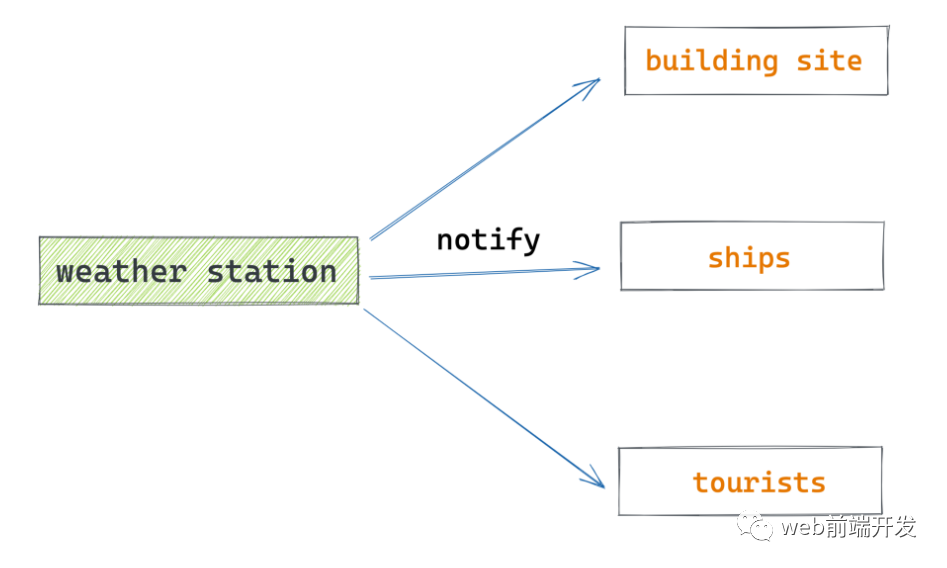
但仔细想想,其实,从逻辑上讲,建筑工地、船舶、游客都应该依靠天气预报,他们应该是积极的一方。
我们可以将依赖项更改为如下所示:
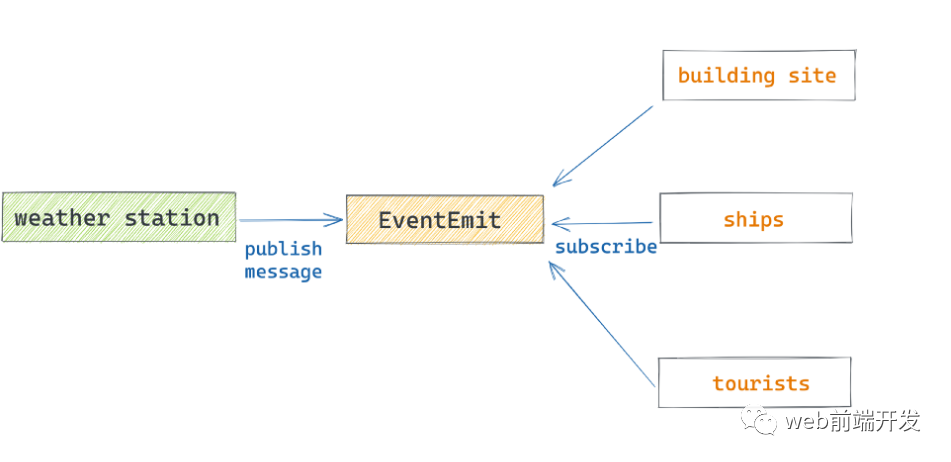
气象站发布通知,然后触发事件,建筑工地、船舶和游客订阅该事件。
气象站不需要关心哪些对象关注天气预警,只需要直接触发事件即可。然后需要了解天气状况的单位主动订阅该事件。
这样,气象站与订阅者解耦,订阅者之间也解耦。如果有新的订阅者,那么它只需要直接订阅事件,而不需要修改现有的代码。
当然,为了完成这个发布-订阅系统,我们还需要实现一个事件订阅和分发系统。
可以这样写:
const EventEmit = function() {this.events = {};this.on = function(name, cb) {if (this.events[name]) {this.events[name].push(cb);} else {this.events[name] = [cb];}};this.trigger = function(name, ...arg) {if (this.events[name]) {this.events[name].forEach(eventListener => {eventListener(...arg);});}};};
我们之前的代码,重构以后变成这样:
let weatherEvent = new EventEmit()weatherEvent.on('warning', function () {// buildingsite.stopwork()console.log('buildingsite.stopwork()')})weatherEvent.on('warning', function () {// ships.mooring()console.log('ships.mooring()')})weatherEvent.on('warning', function () {// tourists.canceltrip()console.log('tourists.canceltrip()')})weatherEvent.trigger('warning')
如果你的项目中存在多对一的依赖,并且每个模块相对独立,那么你可以考虑使用发布-订阅模式来重构你的代码。
事实上,发布订阅模式应该是我们前端开发者最常用的设计模式。
element.addEventListener('click', function(){//...})// this is also publish-subscribe pattern
03、代理模式
现在我们的页面上有一个列表:
<ul id="container"><li>Jon</li><li>Jack</li><li>bytefish</li><li>Rock Lee</li><li>Bob</li></ul>
我们想给页面添加一个效果:每当用户点击列表中的每个项目时,都会弹出一条消息:Hi, I'm ${name}
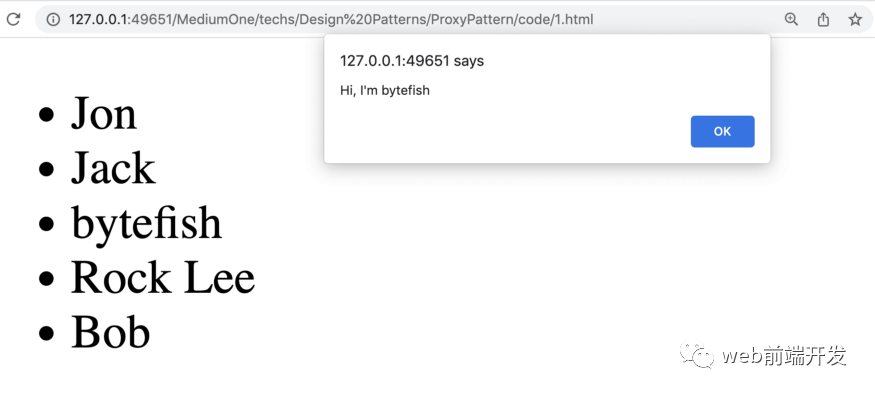
我们将如何实现此功能?
大致思路是给每个li元素添加一个点击事件。
<html lang="en"><head><meta charset="UTF-8"><meta name="viewport" content="width=device-width, initial-scale=1.0"><meta http-equiv="X-UA-Compatible" content="ie=edge"><title>Proxy Pattern</title></head><body><ul id="container"><li>Jon</li><li>Jack</li><li>bytefish</li><li>Rock Lee</li><li>Bob</li></ul><script>let container = document.getElementById('container')Array.prototype.forEach.call(container.children, node => {node.addEventListener('click', function(e){e.preventDefault()alert(`Hi, I'm ${e.target.innerText}`)})})</script></body></html>
这种方法可以满足要求,但这样做的缺点是性能开销,因为每个 li 标签都绑定到一个事件。如果列表中有数千个元素,我们是否绑定了数千个事件?
如果我们仔细看这段代码,可以发现当前的逻辑关系如下:

每个 li 都有自己的事件处理机制。但是我们发现不管是哪个li,其实都是ul的成员。我们可以将li的事件委托给ul,让ul成为这些 li 的事件代理。
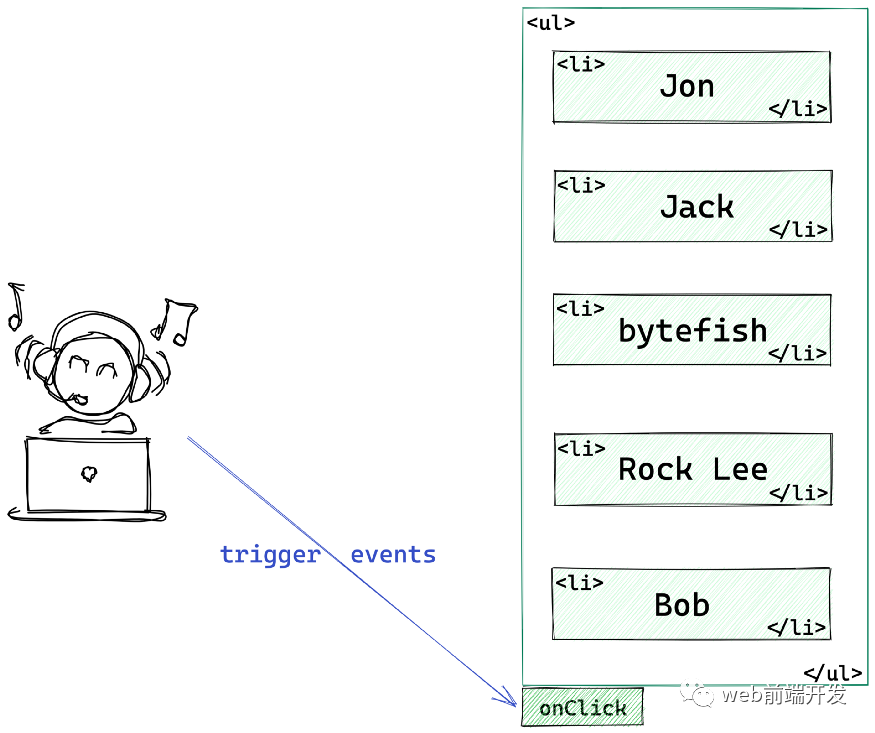
这样,我们只需要为这些 li 元素绑定一个事件。
let container = document.getElementById('container')container.addEventListener('click', function (e) {console.log(e)if (e.target.nodeName === 'LI') {e.preventDefault()alert(`Hi, I'm ${e.target.innerText}`)}})
这实际上是代理模式。
代理模式是本体不直接出现,而是让代理解决问题。
在上述情况下,li 并没有直接处理点击事件,而是将其委托给 ul。
现实生活中,明星并不是直接出来谈生意,而是交给他们的经纪人,也就是明星的代理人。
代理模式的应用非常广泛,我们来看另一个使用它的案例。
假设我们现在有一个计算函数,参数是字符串,计算比较耗时。同时,这是一个纯函数。如果参数相同,则函数的返回值将相同。
function compute(str) {// Suppose the calculation in the funtion is very time consumingconsole.log('2000s have passed')return 'a result'}
现在需要给这个函数添加一个缓存函数:每次计算后,存储参数和对应的结果。在接下来的计算中,会先从缓存中查询计算结果。
你会怎么写代码?
当然,你可以直接修改这个函数的功能。但这并不好,因为缓存并不是这个功能的固有特性。如果将来您不需要缓存,那么,您将不得不再次修改此功能。
更好的解决方案是使用代理模式。
const proxyCompute = (function (fn){// Create an object to store the results returned after each function execution.const cache = Object.create(null);// Returns the wrapped functionreturn function (str) {// If the cache is not hit, the function will be executedif ( !cache[str] ) {let result = fn(str);// Store the result of the function execution in the cachecache[str] = result;}return cache[str]}})(compute)
这样,我们可以在不修改原函数技术的情况下为其扩展计算函数。
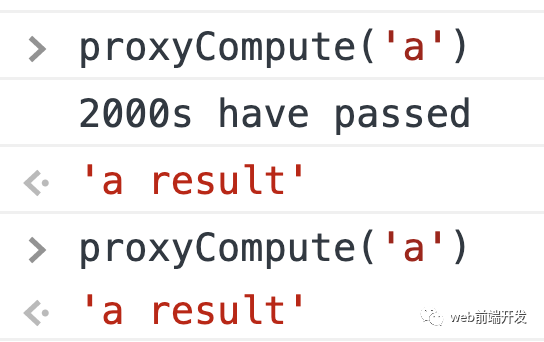
这就是代理模式,它允许我们在不改变原始对象本身的情况下添加额外的功能。
结论
这些是我在日常项目中使用的设计模式。设计模式不是无聊的概念,它们是使我们的代码易于扩展的技术解决方案。
最后,希望这些例子对你有用,感谢阅读。
学习更多技能
请点击下方公众号
![]()

